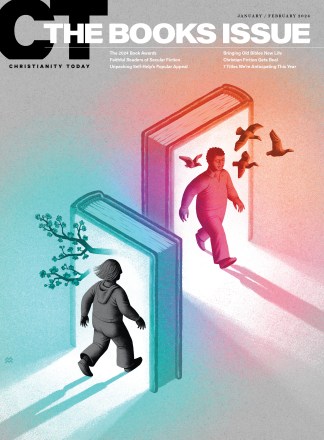This is an excerpt from The Evangelical Imagination, which was a finalist in the Culture and the Arts category of CT’s 2024 Book Awards.
Many of us associate imagination with children’s playtime, creative problem-solving, and hobbits.
Imagination might seem to be merely a fun but optional exercise, enjoyable but indulgent. We also tend to think of it as an individual ability or gift. “Use your imagination,” we say. Or “She’s really imaginative,” we might observe about someone else curiously. Most of us aren’t likely to think of imagination as something arising from our communal experience and exerting tremendous influence on our social lives, let alone our religious beliefs and practices.
But the power of the imagination is large, pervasive, and overwhelming. Imagination entails much more than our individual fancies and visions, and its hold on us reaches far beyond the limits of our own minds. The imagination shapes us and our world more than any other human power or ability. Communities, societies, movements, and, yes, religions are formed and fueled by the power of the imagination.
Evangelicals are no exception. Now, this is not to suggest that the Holy Scriptures or confessional creeds or cloud of great witnesses are figments of our imagination. By no means. Rather, the evangelical imagination—like any imagination at the heart of any culture—has been forming a particular kind of people, and those people have been helping to form the world for hundreds of years. But what is the evangelical imagination?
First, we must consider the imagination itself. At its most literal level, the word imagination refers to the mind’s process of making an image: the act of imaging. In this way, imagination is simple. At this level, it is also very much an individual, solitary behavior.
Yet, much surrounds this image-making activity that includes far more than an individual making an image independently in one’s own mind. The images our minds make are drawn from the objects we perceive, just as the phenomena we perceive through our bodies come through the senses. As Owen Barfield explains, there’s “no such thing as an unseen rainbow.” What we perceive depends on what makes up our surroundings.
It also depends on what we are paying attention to. What we pay attention to derives from a host of experiences, associations, emotions, thoughts, practices, and habits.
While the work of imagination contributes to the making of a culture, a culture in turn provides individuals with a precognitive framework—a framework that includes unconscious, unarticulated, and unstated underlying assumptions—that directs, shapes, and forms our thoughts and desires and imaginations in ways we don’t necessarily recognize.
Think of the unseen parts that form the structure of a house. Philosopher Charles Taylor calls these frameworks “social imaginaries.” In his early work Modern Social Imaginaries, Taylor defines the social imaginary as a culture’s shared pool of “images, stories, and legends” that shape one’s social existence and expectations and “the deeper normative notions and images that underlie these expectations.” The social imaginary forms a “common understanding that enables us to carry out the collective practices that make up our social life.”
Nearly a century ago, Virginia Woolf perceived this problem as she wrestled with the art of representing a life through memoir and biography: “Consider what immense forces society brings to play upon each of us, how that society changes from decade to decade; and also from class to class,” she wrote, pointing out the need to examine the “invisible presences” in our lives. “I see myself as a fish in a stream; deflected; held in place; but cannot describe the stream.”
To be an evangelical is to inherit social imaginaries that have been developing for as long as evangelicalism has existed as a coherent movement. That movement, in turn, participates in the longer history of the modern age.
Writing about a recent dustup over the definition of evangelical and who might rightly (or wrongly) be described as one, historian Kristin Kobes Du Mez draws on Benedict Anderson’s Imagined Communities in observing that evangelicalism is “an imagined religious community.” There are, she argues, “many evangelicalisms,” and they are “imagined” in the sense that it “has always been a dynamic, fluid movement, or series of movements, imagined and maintained through networks, alliances and authority structures, each drawing and enforcing the boundaries of ‘evangelicalism’ for varying purposes.”
Who or what an evangelical is differs if that question is being asked by a church historian, a pastor, a politician, a pollster, or the marketing director of a book publisher.
Of course, most labels are imaginary, as elastic as language itself. Labels are tools that are both helpful and limiting. Whether or not one goes by the label “evangelical” or whether the label goes by the wayside at some point, there still exists a group of Christians here in America and around the globe, within various denominations, who believe Christ is their personal Savior, the Bible is God’s authoritative Word, Christianity can change lives, and that message is worth sharing. We have a history that cannot be rewritten. But that history can be better understood in the present as we write the future.
While there are many approaches and angles to consider in understanding that history, one that has not been examined often or closely enough is the evangelical imagination. By this, I really mean the evangelical social imaginaries, the collective pool of ideas, images, and values that have filled our books, our thoughts, our sermons, our songs, our blog posts, and our imaginations and have thereby created an evangelical culture.
In Apostles of Reason, Molly Worthen examines the history of ideas, particularly those around authority, which have formed American evangelicalism as we know it today. She sees as central to evangelical existence the tensions inherent in a movement emphasizing individual, subjective experience while being based on the external, objective authority of God and his Word. By Worthen’s account, evangelicalism is characterized by competing claims of authority. Evangelicals “are the children of estranged parents—Pietism and Enlightenment—but behave like orphans,” she writes. “This confusion over authority is both their greatest affliction and their most potent source of vitality.”
One fruit of this confusion is a “fraught relationship with secular reason and imagination.” She writes, “If American evangelicals do not share a single mind, they do share an imagination.” Rather than speak of an “evangelical mind,” as many historians and critics are wont to do, Worthen suggests it “may be wiser to speak instead of an ‘evangelical imagination.’” She explains,
In every individual, the imagination is the faculty of mind that absorbs ideas and sensations as fuel to conjure something new. It is a tool for stepping outside oneself or plunging into egocentric delusion. But we might also speak of the imagination that a community shares, no matter how furious its internal quarrels: a sphere of discourse and dreaming framed by abiding questions about how humans know themselves, their world, and their God.
The ingredients of the modern imagination and the evangelical imagination may not be universal or eternal, but they are pervasive and formative. The elements of the social imaginaries of the evangelical movement—such as conversion, testimony, reformation, and rapture—are representative and, to my thinking, central to what has formed the evangelical imagination for 300 years.
Of course, the images and ideas found within the evangelical social imaginary don’t necessarily belong to evangelicalism alone. Some, in fact, are part of the larger modern social imaginary and have become part of the evangelical imagination because evangelicalism is a product of modernity. Within the current evangelical context, some of these ideas may be as representative of America as they are of evangelicalism.
The fact is that 21st-century American evangelicalism can hardly be separated from either the modern age or the American dream. As Willie James Jennings says in The Christian Imagination, “Christianity in the Western world lives and moves within a diseased social imagination.”
It is not simply that Christianity and evangelicalism are infected by other ideologies and identities—it’s also that too often we don’t recognize their undue influence on our beliefs, narratives, images, traditions, and institutions.
Wherever our evangelical imaginations are informed and formed by modernity, Romanticism, Victorianism, or any -ism other than the tenets of our faith, the disease will fester. This also means that it is hardly possible, as noted above, to talk about evangelicalism rather than evangelicalisms. This now-global movement is not contained by the qualities and characteristics of a George Whitefield, John Wesley, Jonathan Edwards, or any of its other founders and leaders.
This is not to say that all that is cultural is bad—or good. Human beings exist in culture, and that is by God’s design. As James K. A. Smith explains in Imagining the Kingdom, “It is because I imagine the world (and my place in it) in certain ways that I am oriented by fundamental loves and longings. … My longings are not simply ‘chosen’ by me; they are not self-generated ‘decisions.’ … We don’t choose desires; they are birthed in us.”
The social imaginary primes us even before we make any decision on our own. Gaining our bearings requires us to first recognize that we have been oriented—much the way that the one who is “it” is blindfolded, spun around, and left flailing. Only when the blindfold is removed will we see what direction we are facing, and only then can we decide which turns to take as we move forward.
The metaphors, images, and stories we live by orient us. To recognize these metaphors, images, and stories—and to understand their power as part of the imagination we share—is to remove the blindfold and to see.
Karen Swallow Prior is a speaker and author. Content adapted from The Evangelical Imagination by Karen Swallow Prior, ©2023. Used by permission of Brazos Press, a division of Baker Publishing Group.













